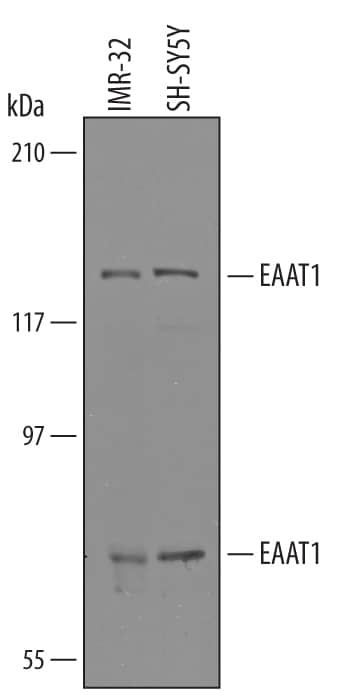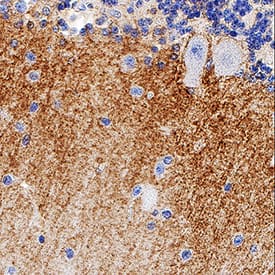EAAT1/GLAST-1 Products
Excitatory Amino Acid Transporter 1 (EAAT1), also known as GLAST-1 and SLC1A3, is a member of the SDF symporter family of proteins. Human EAAT1/GLAST-1 is a 542 amino acid (aa), 8-transmembrane variably glycosylated protein with a predicted molecular weight of 60-62 kDa. Its N- and C-terminus are cytoplasmic. EAAT1/GLAST-1 homodimers are reported to exist, but only when the protein is glycosylated. There are at least two potential isoform variants. One shows an Arg substitution for aa 430-475, while a second shows a four aa substitution for aa 62-542.
Over the extracellular loop that encompasses aa 146-237, human EAAT1/GLAST-1 shares 92% aa identity with the mouse ortholog. EAAT1/GLAST-1 is expressed by glia, fibroblasts, and select neuron cell types such as hippocampal neurons. EAAT1/GLAST-1 is known to transport L-glutamate into glia, thus removing glutamate from synaptic areas where it either acts too long or becomes toxic at elevated concentrations. Its action is dependent on its ability to cotransport sodium. Aberrant expression of EAAT1/GLAST-1 is associated with multiple neurological and neurodegenerative disorders including epilepsy and multiple sclerosis.
Products:
169 results for "EAAT1/GLAST-1" in Products
169 results for "EAAT1/GLAST-1" in Products
EAAT1/GLAST-1 Products
Excitatory Amino Acid Transporter 1 (EAAT1), also known as GLAST-1 and SLC1A3, is a member of the SDF symporter family of proteins. Human EAAT1/GLAST-1 is a 542 amino acid (aa), 8-transmembrane variably glycosylated protein with a predicted molecular weight of 60-62 kDa. Its N- and C-terminus are cytoplasmic. EAAT1/GLAST-1 homodimers are reported to exist, but only when the protein is glycosylated. There are at least two potential isoform variants. One shows an Arg substitution for aa 430-475, while a second shows a four aa substitution for aa 62-542.
Over the extracellular loop that encompasses aa 146-237, human EAAT1/GLAST-1 shares 92% aa identity with the mouse ortholog. EAAT1/GLAST-1 is expressed by glia, fibroblasts, and select neuron cell types such as hippocampal neurons. EAAT1/GLAST-1 is known to transport L-glutamate into glia, thus removing glutamate from synaptic areas where it either acts too long or becomes toxic at elevated concentrations. Its action is dependent on its ability to cotransport sodium. Aberrant expression of EAAT1/GLAST-1 is associated with multiple neurological and neurodegenerative disorders including epilepsy and multiple sclerosis.
Products:
| Reactivity: | Human, Mouse, Rat |
| Details: | Rabbit IgG Polyclonal |
| Applications: | IHC, WB, ELISA, ICC/IF, Flow, +2 More |
| Reactivity: | Human |
| Details: | Sheep IgG Polyclonal |
| Applications: | WB, IHC |
| Reactivity: | Human, Mouse |
| Details: | Rabbit Polyclonal |
| Applications: | IHC, WB, ICC/IF, Flow |
Recombinant Monoclonal Antibody
| Reactivity: | Human, Mouse, Rat |
| Details: | Rabbit IgG Monoclonal Clone #7Y4U5 |
| Applications: | IHC, WB |
| Reactivity: | Human |
| Details: | Rabbit IgG Polyclonal |
| Applications: | IHC, ICC/IF |
| Reactivity: | Human |
| Details: | Mouse IgG2b Monoclonal Clone #482420 |
| Applications: | IHC |
| Reactivity: | Human |
| Details: | Sheep IgG Polyclonal |
| Applications: | WB, IHC |
| Reactivity: | Human |
| Details: | Sheep IgG Polyclonal |
| Applications: | WB, IHC |
| Reactivity: | Human |
| Details: | Sheep IgG Polyclonal |
| Applications: | WB, IHC |
| Reactivity: | Human |
| Details: | Sheep IgG Polyclonal |
| Applications: | WB, IHC |
| Reactivity: | Human |
| Details: | Sheep IgG Polyclonal |
| Applications: | WB, IHC |
| Reactivity: | Human |
| Details: | Sheep IgG Polyclonal |
| Applications: | WB, IHC |
| Reactivity: | Human |
| Details: | Sheep IgG Polyclonal |
| Applications: | WB, IHC |
| Reactivity: | Human |
| Details: | Sheep IgG Polyclonal |
| Applications: | WB, IHC |
| Reactivity: | Human |
| Details: | Rabbit IgG Polyclonal |
| Applications: | IHC |
| Reactivity: | Human |
| Details: | Mouse IgG2b Monoclonal Clone #482420 |
| Applications: | IHC |
| Reactivity: | Human |
| Details: | Mouse IgG2b Monoclonal Clone #482420 |
| Applications: | IHC |
| Reactivity: | Human |
| Details: | Mouse IgG2b Monoclonal Clone #482420 |
| Applications: | IHC |
| Reactivity: | Human |
| Details: | Mouse IgG2b Monoclonal Clone #482420 |
| Applications: | IHC |
| Reactivity: | Human |
| Details: | Mouse IgG2b Monoclonal Clone #482420 |
| Applications: | IHC |
| Reactivity: | Human |
| Details: | Mouse IgG2b Monoclonal Clone #482420 |
| Applications: | IHC |
| Reactivity: | Human |
| Details: | Mouse IgG2b Monoclonal Clone #482420 |
| Applications: | IHC |
| Reactivity: | Human |
| Details: | Mouse IgG2b Monoclonal Clone #482420 |
| Applications: | IHC |
Recombinant Monoclonal Antibody
| Reactivity: | Human, Mouse, Rat |
| Details: | Rabbit IgG Monoclonal Clone #SR2039 |
| Applications: | IHC, WB |
| Applications: | AC |

![Flow (Intracellular): EAAT1/GLAST-1/SLC1A3 Antibody - BSA Free [NB100-1869] Flow (Intracellular): EAAT1/GLAST-1/SLC1A3 Antibody - BSA Free [NB100-1869]](https://resources.bio-techne.com/images/products/EAAT1-GLAST-1-SLC1A3-Antibody-Flow-Intracellular-NB100-1869-img0011.jpg)


![Immunocytochemistry/ Immunofluorescence: EAAT1/GLAST-1/SLC1A3 Antibody - BSA Free [NBP3-05771] Immunocytochemistry/ Immunofluorescence: EAAT1/GLAST-1/SLC1A3 Antibody - BSA Free [NBP3-05771]](https://resources.bio-techne.com/images/products/EAAT1-GLAST-1-SLC1A3-Antibody-Immunocytochemistry-Immunofluorescence-NBP3-05771-img0004.jpg)
![Western Blot: EAAT1/GLAST-1/SLC1A3 Antibody (7Y4U5) [NBP3-16865] - EAAT1/GLAST-1/SLC1A3 Antibody (7Y4U5)](https://resources.bio-techne.com/images/products/nbp3-16865_rabbit-eaat1-glast-1-slc1a3-mab-7y4u5-52202511402769.jpg)
![Immunohistochemistry-Paraffin: EAAT1/GLAST-1/SLC1A3 Antibody [NBP1-84940] Immunohistochemistry-Paraffin: EAAT1/GLAST-1/SLC1A3 Antibody [NBP1-84940]](https://resources.bio-techne.com/images/products/EAAT1-GLAST-1-SLC1A3-Antibody-Immunohistochemistry-Paraffin-NBP1-84940-img0017.jpg)

![Immunohistochemistry-Paraffin: EAAT1/GLAST-1/SLC1A3 Antibody [NBP1-84939] Immunohistochemistry-Paraffin: EAAT1/GLAST-1/SLC1A3 Antibody [NBP1-84939]](https://resources.bio-techne.com/images/products/EAAT1-GLAST-1-SLC1A3-Antibody-Immunohistochemistry-Paraffin-NBP1-84939-img0015.jpg)
![Western Blot: EAAT1/GLAST-1/SLC1A3 Antibody (SR2039) [NBP3-21738] -](https://resources.bio-techne.com/images/products/nbp3-21738_rabbit-eaat1-glast-1-slc1a3-mab-sr2039-6720239533724.jpg)